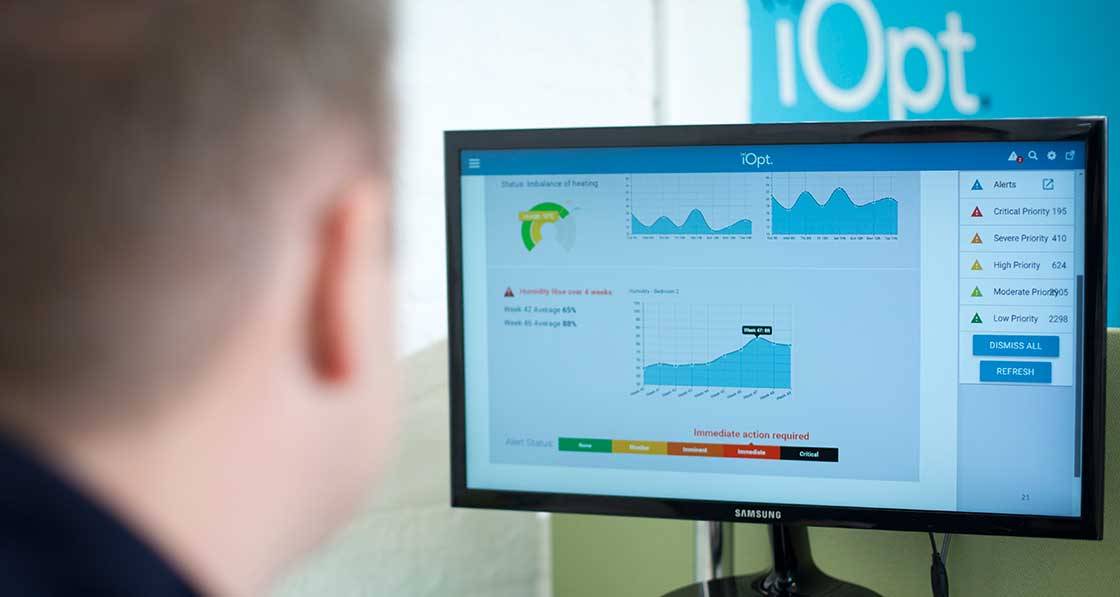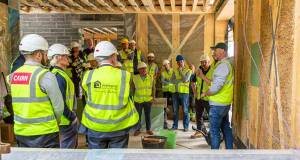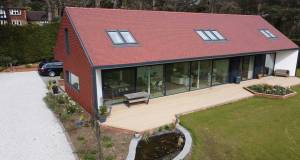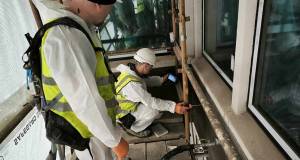
- Marketplace
- Posted
Remote home monitoring can help in Covid fight – iOpt Assets
Glasgow-based remote home sensing provider iOpt Assets believes its digital monitoring service can help to significantly limit maintenance visits by local authority and housing association staff, reducing one potential avenue of infection spread during the Covid-19 pandemic.
This article was originally published in issue 34 of Passive House Plus magazine. Want immediate access to all back issues and exclusive extra content? Click here to subscribe for as little as €10, or click here to receive the next issue free of charge
iOpt Assets provides a remote sensing service that enables housing stock owners to remotely monitor temperature, humidity and CO2 in the buildings they manage. This dynamic information is then correlated with static information like house type, build method, insulation levels, and occupancy levels, as provided by the landlord.
“When combined, this provides a powerful mix of information that can be used to anticipate problems like damp and mould, fuel poverty, poor indoor air quality, changes in occupancy levels, and heating system failures,” iOpt Assets director Dane Ralston told Passive House Plus.
“And in the age of Covid-19, we believe this can be hugely helpful in reducing the need for local authority and housing association staff to visit their properties, helping to prevent the spread of infection.”
Ralston continued: “Most of our clients start off interested principally in monitoring energy efficiency and temperatures, but quickly realise they can learn a whole lot more about conditions in the properties. It’s not about just about looking at temperature, or CO2, or humidity, but about how these interact with the lifestyle of the occupants, and with the ways the properties are insulated and heated. This provides a very powerful set of data.”
The company provides real time, accurate data on housing conditions, and early warnings of potential issues, to its clients. Three or four wireless sensors are typically installed in an average two or three-bed property. The company’s software platform then interprets the data gleaned from sensors and information about the house to predict when and where issues such as mould growth will arise, using iOpt’s bespoke algorithms and machine learning techniques.
Ralston said it was interesting to note that in May 2020, CO2 levels in dwellings it monitors rose on average by about 40% compared to May 2019, because far more people were working at home and staying inside.
“We worry that if Covid-19 comes back for a second wave in winter, that will have a massive impact in terms of people spending more time inside, and keeping windows closed, leading to worsening indoor air quality and lack of ventilation.”
iOpt Assets uses the LoRa radio network for its remote sensing.
“We’re looking at developing our monitoring capabilities further to work at the ’smart city’ level to look at how indoor air quality is impacted by external factors such as traffic pollution.”
To find out more see www.ioptassets.com
Related items
-
 New Ejot profile cuts thermal bridging losses by 25mm insulation equivalent
New Ejot profile cuts thermal bridging losses by 25mm insulation equivalent -
 Build Homes Better updates Isoquick certification to tackle brick support challenge
Build Homes Better updates Isoquick certification to tackle brick support challenge -
 Ecological Building Systems expands UK and Irish straw panel construction with EcoCocon deal
Ecological Building Systems expands UK and Irish straw panel construction with EcoCocon deal -
 Focus on better buildings, not better spreadsheets
Focus on better buildings, not better spreadsheets -
 MBC offers total passive house envelope solutions
MBC offers total passive house envelope solutions -
 Historic Dublin building retrofitted with cutting edge insulation
Historic Dublin building retrofitted with cutting edge insulation

